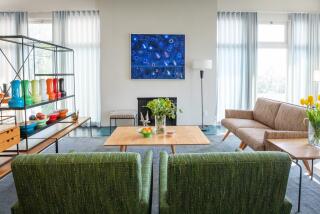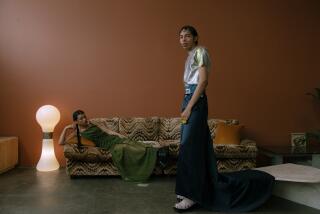Eschewing the Rat Race for the Work Habits of the 18th Century
- Share via
When you think of a woodworking shop, you don’t usually imagine a place where bird song outside is louder than the work going on inside.
But such a place is Hubbard Cabinetmakers in Butler, Md., where two cousins are building their future and a business on the furniture-making traditions of the past.
One recent day, Fife Hubbard was carving naturalistic details in the ball-and-claw foot of one leg of a small dressing table, while his cousin, Crawford Hubbard, carefully painted carpenter’s glue on the “breadboard” ends of a trestle table top. At the back of the shop, their co-worker Mike Clarkson was using a hand scraper to shape a chair leg. The only modern sound was a radio murmuring in the background.
Jack, the shaggy Newfoundland shop dog, snoozed on his cushion, surrounded by various pieces of exquisite 18th and 19th century-style furniture in various states of completion--the trestle legs for Crawford’s table, a nearly finished jewelry box Fife is making for his sister-in-law, chairs with and without legs or backs and a stunning tiger maple tall-case clock, awaiting its finish.
The clock, which Fife Hubbard designed and built, “is loosely modeled on Pennsylvania clocks,” he says.
“Loosely” is just about the opposite of how the Hubbards and their work are connected to the past.
They are committed to using the finest materials and workmanship, and the style in which they work is firmly planted in the New England and mid-Atlantic styles of two to three centuries ago. They create their own designs, and they make all their own patterns. They use old tools when it matters. They each work on one piece until it’s complete.
But it is, after all, 2000, and not 1800, so while, as in the older tradition, each piece of furniture, each decorative item, that comes out of the shop is custom-made for a waiting client, Hubbard furniture functions in a modern world. A serpentine chest--the piece that will use the rather scary legs Fife is carving--will become a bathroom vanity. A tall jelly cabinet might be an entertainment center. Beds are built for queen-size mattresses.
“We do some things that are strict reproductions,” says Fife, citing a Dunlap-pattern chest Crawford has been working on. “But mostly we use the 18th century pieces more as precedents than as things to copy.”
The cousins--Fife is 33, Crawford 30--are, at first hearing, unlikely craftsmen. Until a few years ago, Fife was an environmental writer in Maine; Crawford provided technical support for clients of an accounting software company in San Francisco.
But Fife had been bitten early by the furniture-making bug; he and his father, Paull Hubbard (brother of Crawford’s father, A.C. Hubbard), got interested in it about the same time, in the mid-’80s. At first, Fife says, he was interested in “really rustic, post-and-beam” construction. But that proved a hard sell. “I had to make a living.”
So he turned instead to the furniture of his ancestors, including one Joel Joslyn, who worked with craftsmen named Dunlap. The Dunlaps, one of a number of Scots-Irish artisan families who had immigrated to Northern Ireland and then to North America, set up shop about 1765 in Antrim, N.H. After six generations, there are still Dunlaps doing cabinetry in Antrim. Three and a half years ago, Fife moved to Baltimore to be near family.
About 2 1/2 years ago, Crawford, who was finding accounting software mind-deadeningly dull, came to Maryland to visit. When he saw what his cousin was doing, he couldn’t wait to abandon the sterile life of a computer geek for the creative life of a custom cabinetmaker.
When most people hear the word “custom,” they think of kitchen or bath cabinets, or storage or entertainment units--and there are lots of companies making those. In most of these cases, “custom” means made to fit, not individually designed. The kind of work the Hubbards do, which often involves hours of intricate hand-carving, is quite different.
“That kind of [historic] craft tradition is very rare these days--custom cabinetry that really is custom,” says Mayer Rus, editor-in-chief of Interior Design magazine. “That hand-craft tradition seems to be gradually dying out.”
He’s not familiar with the tiny shop’s work--not many people are--but he knows about the economics of a craft approach. “It’s not easy to make a successful business that way,” he says, “which makes it all the more rare.”
But the Hubbards find it works just fine. Clearly there’s a keen artistic sense at work in both cousins--a fine eye for line and proportion. But they have a sense of how to manage their artisan enterprise.
Hubbard pieces are not inexpensive, but they are reasonable for the amount of work required. A Dunlap-style chest or lowboy might cost about $4,000; a tall chest about $6,000 to $7,000. The tall clock Fife is making will cost around $8,000, “because the works are expensive.”
Each of the early New England cabinetmaking shops--usually run by families--had its own style, Fife Crawford says. The Dunlap style features pieces that are both sturdy and exuberant, a tradition to which the Hubbards happily adhere. And one that their clients, living in a world of impersonal e-commerce and declining standards of service, can appreciate.
“It’s very rare that you find anyone who takes so much interest in the piece,” says Toni Griswold, who has had the Hubbards build two pieces for her nearby home--a partner’s desk for her husband and a front hall table. “They really want to please the client--it’s [a trait that is] just so hard to come by these days.” Griswold was touched that the Hubbards used wood from an old house near her home in the new furniture. “It meant so much to have something from there.”
The Hubbards always work closely with clients to develop a design. They visit the home and check out the site of the proposed piece, and then submit sketches--sometimes many sketches. The process from design to delivery can take weeks or months.
There is a practical side to following history, the Hubbards say. When copying or adapting an old piece, Fife says, “you can learn a lot, because [the original designers] have already worked out the proportions.”
When they can’t find a precedent for a particular task, they make something up: that is, they apply logic and experience to come up with a solution. But usually, when they do happen upon some directions, it’s exactly what they have done.
“It’s the nature of the work,” Fife says, “that you often end up doing things the way they were done hundreds of years ago.”
*
Hubbard Cabinetmakers designs and builds custom furniture in the 18th century style. The shop is in Butler, Md. The phone number is (410) 472-1175. The Hubbards build only for custom orders.


